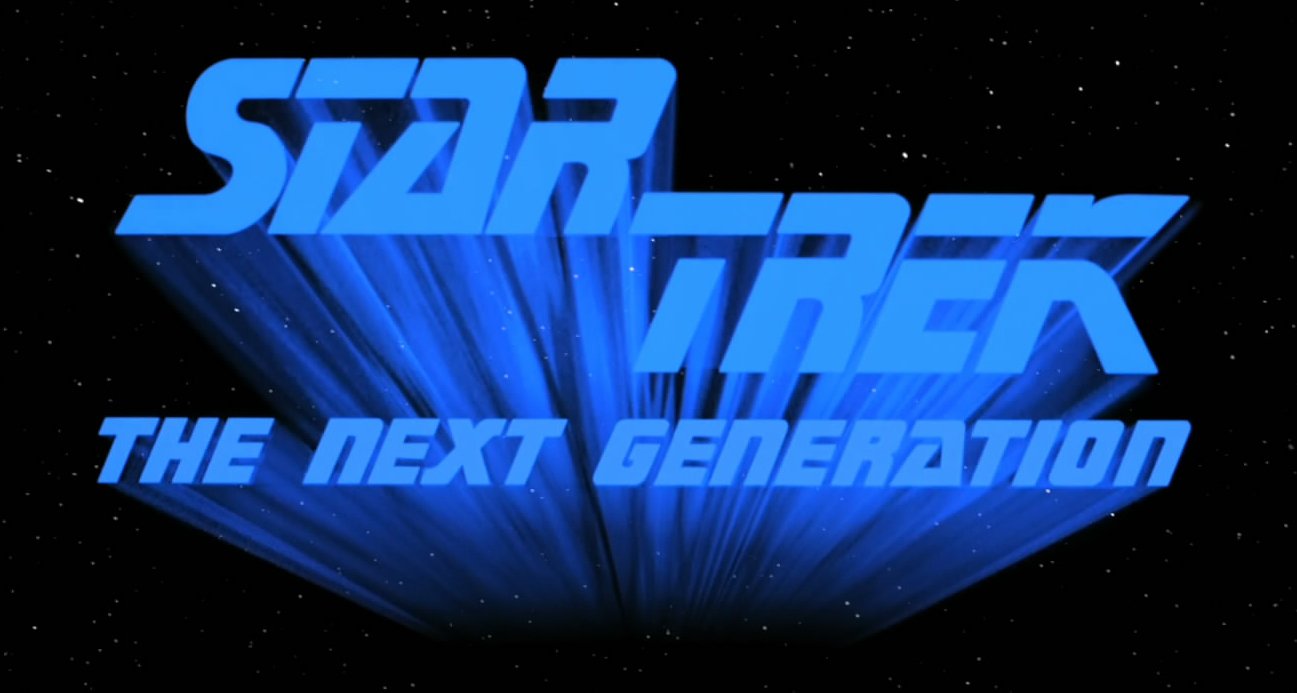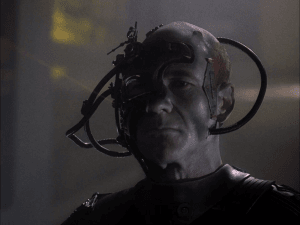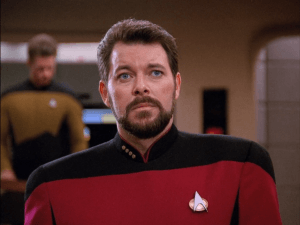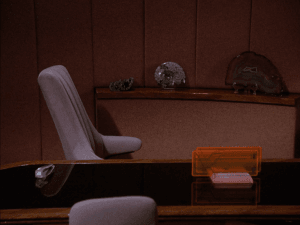
Previously, on ‘Final Frontier Friday’…
Welcome back! Two weeks ago, we kicked off the summer with a look at ‘The Best of Both Worlds‘, the third season finale of ‘Star Trek: The Next Generation’ and the franchise’s first season-ending cliffhanger. Somewhat unsurprisingly, then, we’re continuing that with today’s examination of ‘The Best of Both Worlds, Part II’, which opened the fourth season.
Hey, just be glad I didn’t keep you waiting three months for this one!
I went on at some length last time about how phenomenal the ‘Best of Both Worlds’ cliffhanger is, referring to it as “if not the best season finale that ‘Star Trek’ has to offer, certainly the best cliffhanger’. And even when it aired, the episode struck a chord. Ronald D. Moore, then a staff writer on the series recalled that “all hell broke loose” after the episode aired. Speculation ran rampant, with popular rumors suggesting that Picard’s assimilation would prove to be an elaborate ruse perpetrated by Q or that Picard would actually be killed off in the season opener, leaving Riker in command for keeps.
 It wasn’t just about the cliffhanger itself, though. In Moore’s mind at least, the broadcast of ‘The Best of Both Worlds’ marked the point where ‘TNG’ was finally accepted by fans as something other than the red-headed stepchild of the original series. In his words, “it wasn’t until the ‘Best of Both Worlds’ cliffhanger that you felt the whole gestalt of it shift and suddenly we were ‘Star Trek’.”
It wasn’t just about the cliffhanger itself, though. In Moore’s mind at least, the broadcast of ‘The Best of Both Worlds’ marked the point where ‘TNG’ was finally accepted by fans as something other than the red-headed stepchild of the original series. In his words, “it wasn’t until the ‘Best of Both Worlds’ cliffhanger that you felt the whole gestalt of it shift and suddenly we were ‘Star Trek’.”
All of that combined to create a lot of expectations to live up to. So naturally, the development of the second part was anything but smooth sailing. Then-showrunner Michael Piller, who wrote both parts of the story, had not yet decided whether or not he would return for the fourth season when he wrote ‘The Best of Both Worlds’. Because of that, he didn’t exactly put a ton of thought into how he would write his way out of that particular cliffhanger. In fact, it was only after he had finalized his new contract and returned to the Paramount lot in July 1990 that Piller started to put any serious thought into the resolution of the story that had left fandom on the edge of its collective seat a month previous.
So how did Piller get out of the corner that he’d written himself into? Well, if you’ve seen the episode, then in a way you already know the answer. Piller, who described himself as believing in “zen writing,” which he defined as “[letting] the characters speak and listen to them and I’ll sort of like take notes, while they’re talking.” So for the second part of ‘Best of Both Worlds’, he started writing and worked out the solutions characters’ problems more or less as they did. In fact, the eleventh hour breakthrough that allowed the crew to defeat the Borg – in which the very interconnectedness that gives the Collective its strength was turned against them – likewise came to Piller at the last moment, with the lightbulb going off over his head a mere two days before filming was due to begin.
 So now that we know how Piller wrote the episode, the real question becomes how well that approach worked. Well…
So now that we know how Piller wrote the episode, the real question becomes how well that approach worked. Well…
Picking up from the end of ‘The Best Of Both Worlds’, the Borg (represented by Locutus – formerly Captain Picard) have announced themselves to the Enterprise. Riker – now in command – has given the order to fire, using an experimental anti-Borg weapon adapted from the main deflector.
Nothing happens. The Borg ship shrugs off the attack as though it had never happened. Locutus comes as close as a Borg can to gloating, telling them that the Borg gained Picard’s knowledge of the deflector modifications when they assimilated him, and chillingly addresses Riker as “Number One” in the process.
With the Enterprise no longer a threat, the Borg ship disengages and proceeds toward Earth. Via subspace, Admiral Hanson briefs the senior staff on the Federation’s defense plans. Forty starships are preparing to intercept the Borg at Wolf 359, with Klingon reinforcements en route. Things are so desperate that Starfleet is seriously considering reaching out to the Romulans. The Enterprise is to make repairs and join the armada as soon as possible. Hanson, who out of grim necessity considers Picard a casualty of war, grants Riker a battlefield promotion to captain. On board the cube, the Borg continue the process of assimilating Picard. As they do so, a single tear seems the sole remaining sign of his humanity. Later, Riker taps Shelby to serve as his first officer. Once he does so, Data contacts him from the bridge. Starfleet has engaged the Borg at Wolf 359. On the bridge, they receive a garbled transmission from Hanson, who tells them that the battle is going poorly and that they plan to regroup. Before he can specify a rendezvous point, the transmission is cut off.
 With repairs complete, the Enterprise races to Wolf 359. While en route, the crew brainstorms potential countermeasures, but save for some minor modifications to their existing weapons none will be ready in time, besides which even the best ideas seem to be long shots. After the meeting, Riker finds himself in the ready room, facing Picard’s empty chair and wondering aloud what he would do. Just then, the door chimes. Guinan enters and asks to talk. Before Riker can tell her that this really isn’t the best time, she’s sat down in Picard’s chair and pointed out that she’s used to having the captain’s ear. She tells him that morale is not great, that as much as the crew likes and trusts Riker, they think they’re doomed. When she advises him that the best approach – both to the morale problem and their current situation- is to let go of Picard. Riker indignantly reminds her that he tried to kill Picard just the day before. Guinan corrects him: he tried to kill “whatever that is on the Borg ship.” She reminds Riker that Picard’s presence and influence permeates the ship and that it would be easier if he actually had been killed. When Riker protests that Picard “wrote the book on this ship,” Guinan points out that the only way to beat him – or to save him – might be to write a new book. As she leaves, she indicates the chair, reminding Riker that it’s his now. As the door closes, he sits down. Soon after, the Enterprise arrives at Wolf 359 and finds the wreckage of dozens of starships, including the Melbourne. What was a battlefield is now a graveyard.
With repairs complete, the Enterprise races to Wolf 359. While en route, the crew brainstorms potential countermeasures, but save for some minor modifications to their existing weapons none will be ready in time, besides which even the best ideas seem to be long shots. After the meeting, Riker finds himself in the ready room, facing Picard’s empty chair and wondering aloud what he would do. Just then, the door chimes. Guinan enters and asks to talk. Before Riker can tell her that this really isn’t the best time, she’s sat down in Picard’s chair and pointed out that she’s used to having the captain’s ear. She tells him that morale is not great, that as much as the crew likes and trusts Riker, they think they’re doomed. When she advises him that the best approach – both to the morale problem and their current situation- is to let go of Picard. Riker indignantly reminds her that he tried to kill Picard just the day before. Guinan corrects him: he tried to kill “whatever that is on the Borg ship.” She reminds Riker that Picard’s presence and influence permeates the ship and that it would be easier if he actually had been killed. When Riker protests that Picard “wrote the book on this ship,” Guinan points out that the only way to beat him – or to save him – might be to write a new book. As she leaves, she indicates the chair, reminding Riker that it’s his now. As the door closes, he sits down. Soon after, the Enterprise arrives at Wolf 359 and finds the wreckage of dozens of starships, including the Melbourne. What was a battlefield is now a graveyard.
